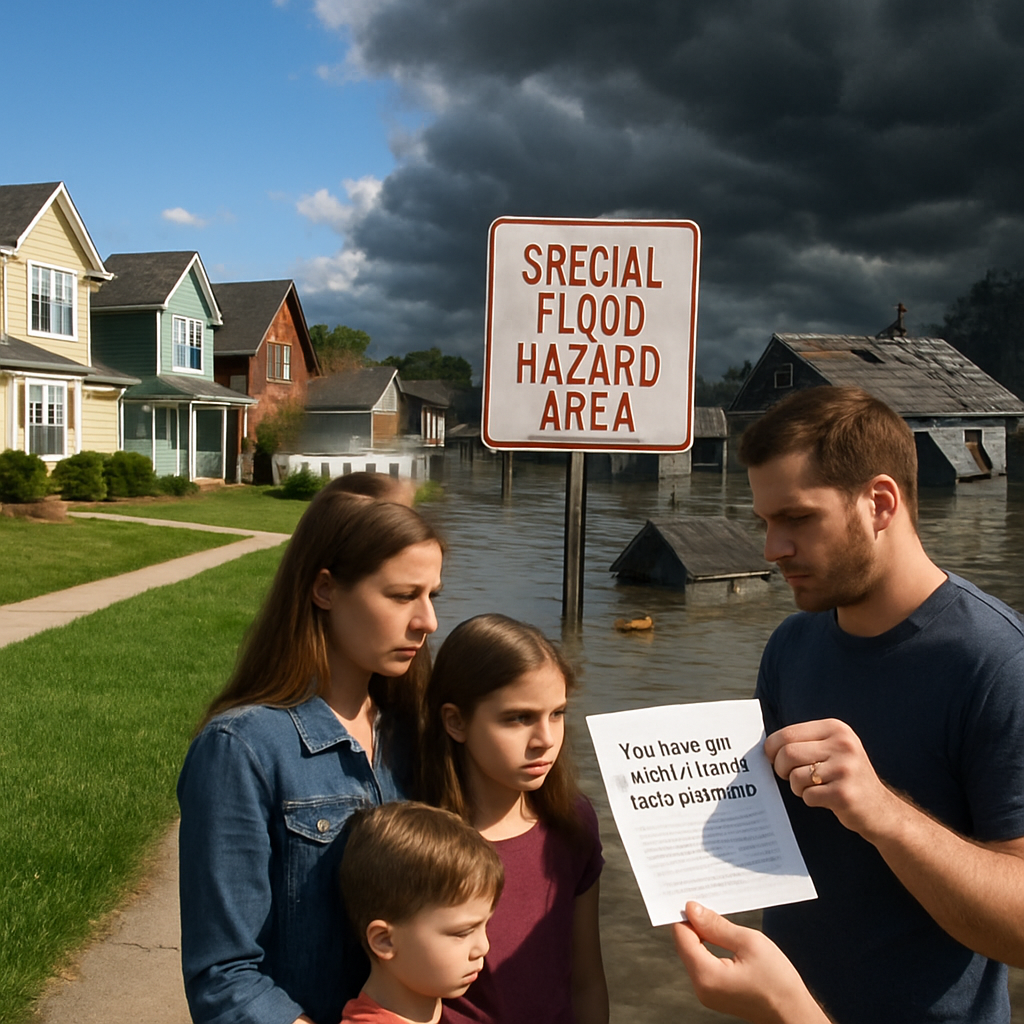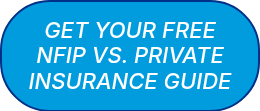The NFIP Shutdown Trap: How Government Failures Leave Homeowners Unprotected
October 9th, 2025
6 min read
By Chris Greene

When the government identifies your flood risk… then leaves you completely unprotected.
The Perfect Storm of Government Failure
If you think the government's flood insurance program will protect you when disaster strikes, think again. During a federal shutdown, the NFIP goes offline—leaving thousands of newly mapped homeowners exposed.
This isn't opinion. It's fact. And it's a perfect example of how government dysfunction can put responsible homeowners directly in harm's way.
Let's break down exactly how it happens—and what you can do to protect your home.
What Happens When You're Newly Mapped into a Flood Zone
It starts with a letter.
That letter isn't optional. When FEMA updates its maps, your mortgage company is required by federal law to make sure you have flood coverage within 45 days.
Under normal circumstances, this process is inconvenient—but manageable:
- NFIP offers a special 1-day waiting period for newly mapped properties
- You can purchase coverage almost immediately
- Your bank is satisfied, and your home is protected
But during a government shutdown? That entire system grinds to a halt.
What Happens During a Government Shutdown
Here's what the typical timeline looks like:
- FEMA updates flood maps.
Your home is now inside a Special Flood Hazard Area. - Your lender sends you a letter.
You have 45 days to secure coverage or risk being out of compliance. - You attempt to buy NFIP coverage.
- Normally: 1-day waiting period for newly mapped homeowners
- During shutdown: ❌ NFIP is completely unavailable
- Private flood insurance remains available.
- ✅ You can purchase coverage even during a shutdown
- ⏳ Standard 15–30 day waiting period applies
- Your lender "makes an exception."
- They temporarily waive your flood insurance requirement
- You remain in a high-risk flood zone with zero coverage
⚠️ "The Newly Mapped Nightmare"
You've done everything right—maintained your mortgage, followed the rules, tried to comply with federal law. But now, because of a political stalemate, the very program that identified your flood risk can't sell you the insurance it requires.
Let that sink in.
The government says your risk is high enough to legally require insurance—then shuts down the only program that's supposed to provide it.
Comparison: NFIP vs. Private Flood Insurance During a Shutdown
| Scenario | NFIP | Private Flood Insurance |
|---|---|---|
| Normal operations (newly mapped) | 1-day waiting period | Standard waiting period (15–30 days) |
| During government shutdown | ❌ Unavailable | ✅ Available |
| Bank compliance | Waiver or exception needed | Can satisfy requirement |
| Protection for your home | ❌ None | ✅ Full coverage (after wait period) |
The Question Every Homeowner Should Ask
Which option is more trustworthy?
Scenario A: The Government Program
- Identifies your home as high-risk
- Legally requires you to buy insurance
- Offers a 1-day waiting period
- Then shuts down and leaves you uncovered
Scenario B: Private Flood Insurance
- Operates 24/7/365—even during shutdowns
- Accessible through independent providers
- Doesn't depend on government funding or politics
- Continues protecting homeowners no matter what Washington does
If you're a homeowner in or near a flood zone, the choice is clear. Private flood insurance isn't a luxury—it's peace of mind.
The 2022 Game Changer: HUD Finally Acknowledges Private Insurance
For decades, homeowners using FHA, VA, or USDA loans were trapped. They could only use NFIP—no alternatives, no exceptions.
That changed on December 21, 2022.
The Department of Housing and Urban Development issued a final rule allowing private flood insurance for government-backed mortgages. This wasn't an innovation—it was an admission that private insurance had proven itself trustworthy all along.
Comparing Pre-2022 vs. Post-2022 Shutdowns
Before 2022 (No Private Option for FHA/VA/USDA)
- NFIP lapse in 2018: Over 40,000 home sales disrupted monthly
- FHA/VA/USDA borrowers completely stuck with no alternatives
- Market paralysis in flood-prone areas
After 2022 (Private Insurance Now Accepted)
- 2025 shutdown: NFIP unavailable, but disruption minimized
- FHA/VA/USDA borrowers can pivot to private insurance
- Transactions continue, families protected
The Bottom Line: The government didn't fix the NFIP's shutdown problem—they just gave Americans an escape hatch to a market that never shuts down. In 2022, HUD finally acknowledged what the private market had proven for 20+ years: private flood insurance is reliable and trustworthy.
The Track Record: 20 Years of Evidence
Here's what many homeowners don't know: There's a persistent fear that private "surplus lines" insurers could leave a state without paying claims.
In 20 years, this has never happened. Not once for us
Meanwhile, in those same 20 years, the NFIP has shut down repeatedly—leaving homeowners unable to access the "trusted" government program when they needed it most.
| Event | Private Flood Insurance | NFIP |
|---|---|---|
| 2010 NFIP Lapse | ✅ Operated normally | ❌ Unavailable ~30 days |
| 2018-2019 Shutdown (35 days) | ✅ Operated normally | Extended before lapse |
| 2023 Shutdown Threats | ✅ Operated normally | Multiple short-term extensions |
| 2025 Shutdown (Current) | ✅ Operating normally | ❌ Unavailable since Sept 30 |
| Abandoned policyholders? | ✅ ZERO incidents in 20 years | ❌ Multiple shutdowns |
The Ultimate Irony
During the 2025 shutdown, countless homeowners in newly mapped flood zones received letters requiring flood coverage within 45 days.
At the exact same time, the NFIP—the only program offering that special 1-day waiting period—was offline.
Banks were forced to issue temporary waivers, not because the flood risk disappeared, but because the government couldn't fulfill its own mandate.
Meanwhile, private flood insurers kept operating as normal. Quotes were available. Policies were issued. Homes were protected.
The NFIP, the so-called "trusted" program, left newly identified high-risk homeowners completely unprotected.
That's not trust. That's systemic failure.
What About Severe Repetitive Loss Properties?
There's one group of homeowners who truly have no choice: owners of Severe Repetitive Loss (SRL) properties.
These are homes that have flooded multiple times with significant claims. Private insurers typically won't cover them—only NFIP will.
During a shutdown, SRL property owners face the worst situation:
- They can't renew with NFIP (shutdown)
- They can't switch to private insurance (insurers won't cover SRL properties)
- They sit completely exposed in the highest-risk properties
The government program that claims to be the safety net for high-risk properties repeatedly pulls that net away during shutdowns. And for SRL properties, there's no backup plan.
How to Protect Your Home (and Sleep Better Tonight)
- Don't wait for FEMA or your bank.
Flood maps change often. Get ahead by understanding your risk now. - Get a private flood insurance quote.
Private markets often provide comparable or lower premiums, faster turnaround, and no shutdown interruptions. - Stay compliant and covered.
A private policy can meet your lender's requirement even when the NFIP can't. - Download our Free Flood Insurance Guide.
Learn how to compare NFIP vs. private coverage and keep your property protected.
Final Word: The "Trust" Question
The NFIP was designed to protect homeowners, not to leave them stranded when politics intervene. Yet, every shutdown proves the same thing: you can't rely on a system that shuts down when you need it most.
The truth is simple:
The government identified your risk, created the requirement, promised the solution—then left you exposed.
That's not trustworthy. That's negligent.
Be proactive. Protect your home. When the government shuts down, your peace of mind doesn't have to.


